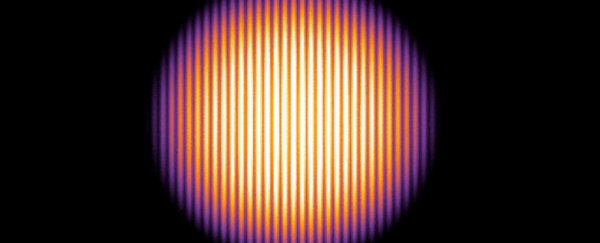At its most simple, matter can come in the form of a solid, a liquid, a gas, or plasma. But what if you could combine the fundamental properties of these separate states to create a strange, hybrid form of matter that somehow exists as both a solid and a liquid?
Two independent teams of physicists say they've managed to do just that, by producing a supersolid - an exotic state of matter that has the crystalline structure of a solid, but flows like a liquid - and they say these could be the first supersolids ever created.
Supersolids should be impossible, because as one of the teams points out, the properties of solids and liquids are usually mutually exclusive.
But the existence of supersolids has been predicted as early as 1969, when Russian physicists hypothesised that the helium-4 isotope could straddle the solid and liquid states simultaneously.
The only problem was that, back then, everyone thought it would be impossible to create a supersolid.
In the following decades, physicists have caught glimpses of the strange quantum state, but the experimental results have been shrouded in uncertainty.
Back in 2004, researchers from Pennsylvania State University announced that they'd achieved what appeared to be a supersolid state by cooling solid helium to less than one-tenth of a degree above absolute zero (around - 273° Celsius).
They were suddenly able to manipulate it way easier than before, which hinted to them that they'd achieved a brand new state of matter with properties of both a solid and a superfluid - a liquid with zero viscosity.
"It's solid in the sense that there is a certain rigidity to it, just like an everyday solid. But it has this very strange property that the matter can flow without any viscosity at all," physicist Ross McKenzie from the University of Queensland, Australia, who wasn't involved in the study, told ABC News at the time.
But the team remained reluctant to actually call what they'd made a supersolid until the process could be replicated, because they could not rule out the possibility that a thin layer of liquid hadn't snuck inside the glass container and skewed the results.
Fast-forward to 2006, when physicist John Reppy from Cornell University - claimed to have debunked the Pennsylvania State supersolid.
The notorious "nemesis of supersolids", Reppy tried to replicate the experiment using a device called a torsional oscillator, and said that the appearance of a supersolid state was simply the result of defects in the crystalline structure,
"[T]he supersolid signal was not due to an intrinsic quantum behaviour of a pure crystal, but was somehow caused by disorder in the structure, which is why it went away when the defects did," Eugenie Samuel Reich explains for Nature.
In 2010, another experiment by Reppy appeared to put another nail in the coffin of supersolids.
As Reich reports, the results suggested that Reppy had discovered a kind of 'quantum plasticity', where solid helium-4 radically increased its softness as its temperature was raised, but then it stiffened again as the temperature is lowered.
"That stiffening would cause the frequency of a torsional oscillator to increase and mimic the supersolid signal," says Reich.
"I'm disappointed that this is turning out to be something other than a supersolid," Reppy said at the time.
Physicists couldn't decide who was right - did the Pennsylvania State team really achieve a supersolid state, or had Reppy debunked it?
Since then, the possible existence of supersolids has remained controversial, but new experimental results from researchers in the US and Switzerland might finally turn things around - or make things even more complicated.
The teams, from MIT and the ETH Zurich, claim to have produced supersolids in an exotic form of matter known as a Bose-Einstein condensate - a state of matter formed at ultra-cold temperatures, where atoms behave like waves.
The benefit of starting with a Bose-Einstein condensate is that it's a superfluid, so you're already halfway there.
As Emily Conover reports for Science News, the teams used different methods to arrive at the same result.
They managed to coax the superfluid into simultaneously behaving like a solid by creating regular density variations in the atoms. This created something that resembled the repeating atomic structure of a solid crystal, but the fluid was still able still flow through this solid system.
In a sense, they'd created matter that can flow through itself, and with zero resistance.
"It's certainly the first case where you can unambiguously look at a system and say this is both a superfluid and a solid," says Sarang Gopalakrishnan from the City University of New York, who wasn't involved in the research.
The claims of achieving a supersolid state are bound to be contentious, and both teams are keeping quiet until the results have been peer-reviewed (they've been submitted to journals and are undergoing the process as we speak).
The biggest uncertainty will be to do with how we define an actual supersolid, and if using Bose-Einstein condensate instead of solid helium-4 is a legitimate method.
"The idea of a supersolid is so strange because superfluid and solid states compete, and in most materials, atoms are forced to choose one or the other," Conover explains.
"But in Bose-Einstein condensates, these two states can more easily live together in harmony, making the weird materials less counterintuitive than supersolid helium-4 would be."
And the fact that these supersolids were created by tweaking the internal structures of the material manually - rather than by simply subjecting it to temperature fluctuations as the Pennsylvania State team did with the solid helium-4 - might be seen as 'cheating'.
We'll have to see if the results can be replicated to know for sure, but it looks like the race to supersolids might have just kicked back into gear, and we're excited to see where it goes.
The results have been published on the pre-print website here (ETH Zurich) and here (MIT).
